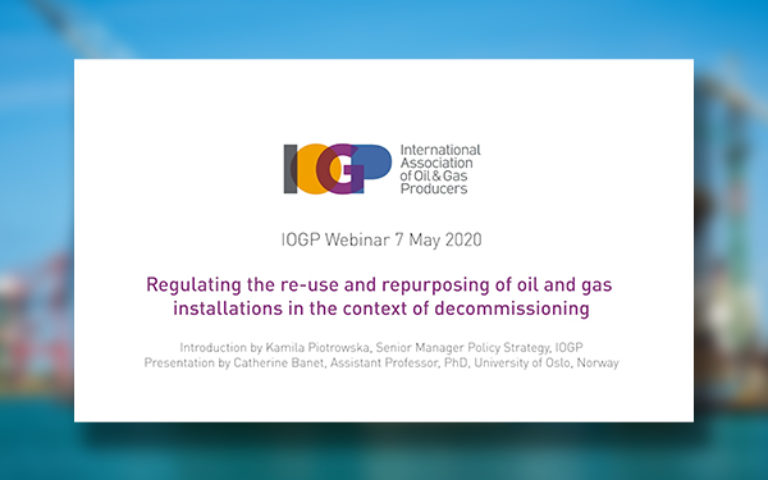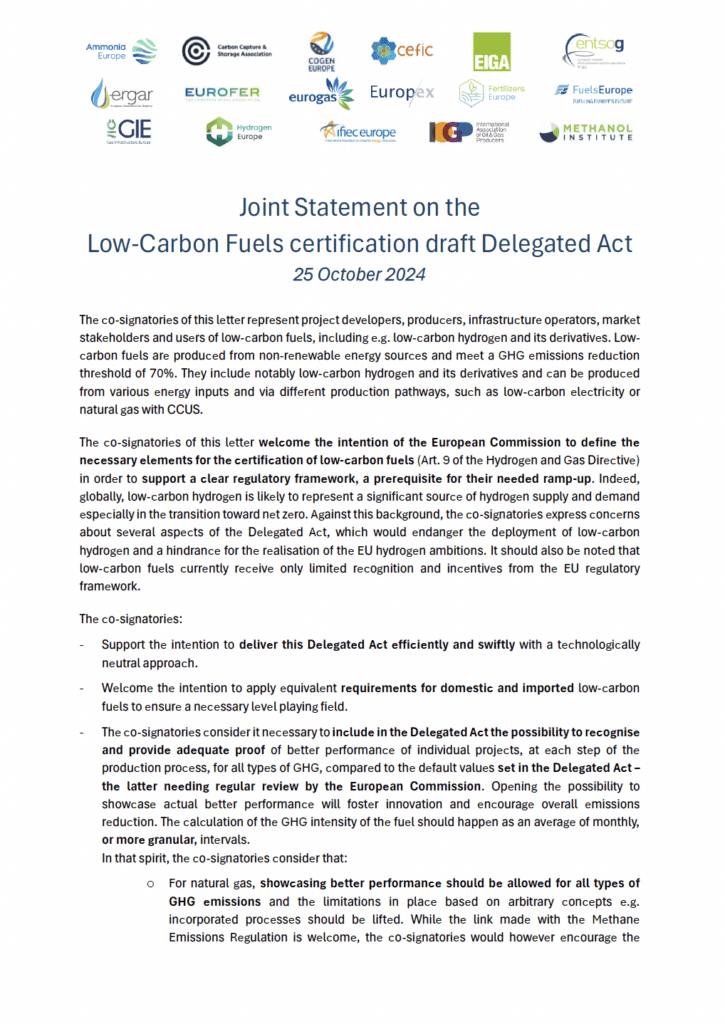The Joint Statement on the Low-Carbon Fuels certification draft Delegated Act
The co-signatories of this letter represent project developers, producers, infrastructure operators, market stakeholders and users of low-carbon fuels, which include e.g. low-carbon hydrogen and its derivatives. Low-carbon fuels are produced from non-renewable energy sources and meet a GHG emissions reduction threshold of 70%. They include notably low-carbon hydrogen and its derivatives and can be produced from various energy inputs and via different productions pathways, such as low-carbon electricity or natural gas with CCUS.
The co-signatories of this letter welcome the intention of the European Commission to define the necessary elements for the certification of low-carbon fuels (Art. 9 of the Hydrogen and Gas Directive) in order to support a clear regulatory framework, a prerequisite for their needed ramp-up. Indeed, globally, low-carbon hydrogen is likely to represent a significant source of hydrogen supply and demand especially in the transition toward net zero. Against this background, the co-signatories express concerns on several aspects of the Delegated Act, which would endanger the deployment of low carbon hydrogen and a hinderance for the realisation of the EU hydrogen ambitions. It should also be noted that low carbon fuels currently receive only limited recognition and incentives from the EU regulatory framework.
The co-signatories:
- Support the intention to deliver this Delegated Act efficiently and swiftly with a technologically neutral approach.
- Welcome the intention to apply equivalent requirements for domestic and imported low-carbon fuels to ensure a necessary level playing field.
- The co-signatories consider necessary to include in the Delegated Act the possibility to recognise and provide adequate proof of better performance of individual projects, at each step of the production process, for all types of GHG, compared to the default values set in the Delegated Act – the latter needing regular review by the European Commission. Opening the possibility to showcase actual better performance will foster innovation and encourage overall emissions reduction. The calculation of the GHG intensity of the fuel should happen as an average of monthly, or more granular,
In that spirit, the co-signatories consider that:- For natural gas, showcasing better performance should be allowed for all types of GHG emissions and the limitations in place based on arbitrary concepts e.g. incorporated processes should be lifted. While the link made with the Methane Emissions Regulation is welcome, the co-signatories would however encourage the European Commission to explicitly clarify how economic operators will be able to showcase better performance, before the implementation of the methodology (2028) than the conservative default values of the Annex B, especially with the +40% premium applied.
- Low carbon fuels producers should also be able to demonstrate better GHG performance on the electricity that they use. Beyond its central role for electrolysers-based LCF production, electricity has also a critical importance for steam methane reforming and methane/LPG pyrolysis processes[1]. The co-signatories acknowledge that opening the possibility of low carbon PPAs could create new challenges, eventually requiring alignment with the RFNBO Delegated Act electricity requirements.
The European Commission is proposing to explore that option only by July 2028: the co-signatories underline that it is likely to hold back financial investment decisions for European manufacturing assets and be detrimental to the emergence of renewable and low-carbon value-chains for hydrogen, fuels and industrial products.
- Support the intention of the European Commission to consider both CCS and CCU but underline the need for clarification on several provisionsg. the conditions/timeline related to the recognition of CCS in third countries, the provisions related to solid carbon or the introduction of the concept of long-lasting products in addition to permanent CCU (from the ETS) should be addressed.
- Stress the importance of considering the technical maturity and availability of hydrogen leakages detection technologies, a prerequisite before their integration to the GHG emissions calculation of low-carbon fuels and RFNBO.
- Welcome the intention to create a link with the RED Union Database and encourage the European Commission to ensure that the traceability provisions defined for renewable gases are also applicable to low-carbon gases[2]. It should also be ensured that LCF imported to Europe are properly recognised within the system.
- Underline the need to ensure regulatory certainty and clarity for project developers, whose timelines extend beyond the already foreseen 2030 review of the Delegated Act (Art. 92 of the Hydrogen and Gas Directive). For projects launched before this review, the co-signatories consider as essential to maintain stable regulatory requirements during their operating lifetime, which may extend beyond the review.
- Encourage the European Commission to facilitate a swift and efficient process of accreditation of Voluntary Certification Schemes, as it is one of the pillars of certification, a necessity to enable supply, trade, and demand for domestic and global volumes.
The co-signatories stand ready to provide further input and encourage the establishment of collaborative stakeholders’ dialogue and forum to shape effective and inclusive policies accelerating the deployment of all low-carbon fuels technologies.
[1] DVGW-EBI, Ecological evaluation of hydrogen supply, 2022
- Publications
- News
- Events
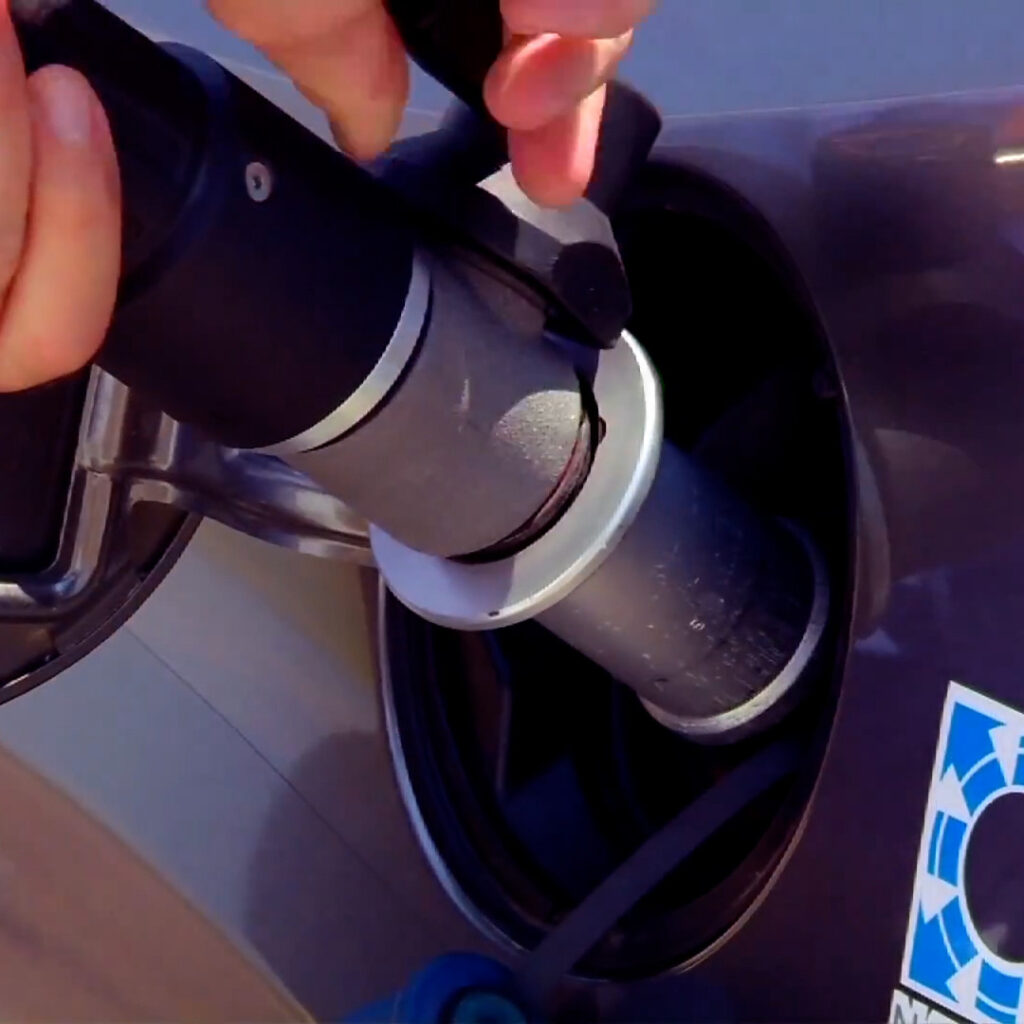
IOGP response to the public consultation on the draft Methodology to determine the greenhouse gas (GHG) emission savings of low-carbon fuels
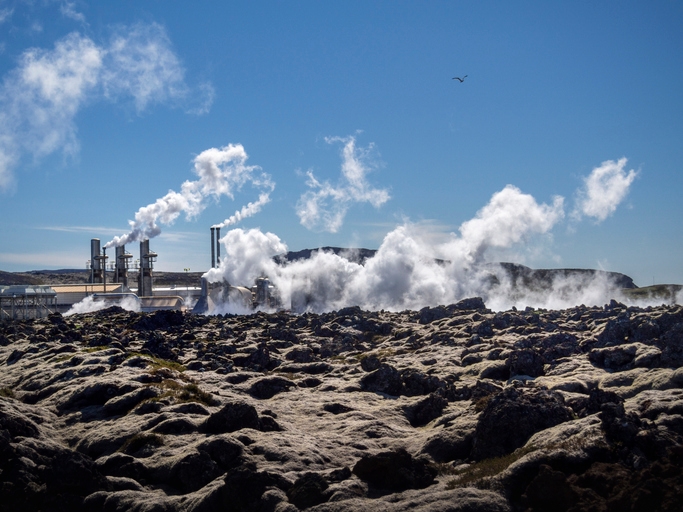
Joint EGEC-IOGP Europe recommendations: Accelerating the deployment of Geothermal in Europe

IOGP Europe key principles on a future regulatory framework for CO2 transport infrastructure
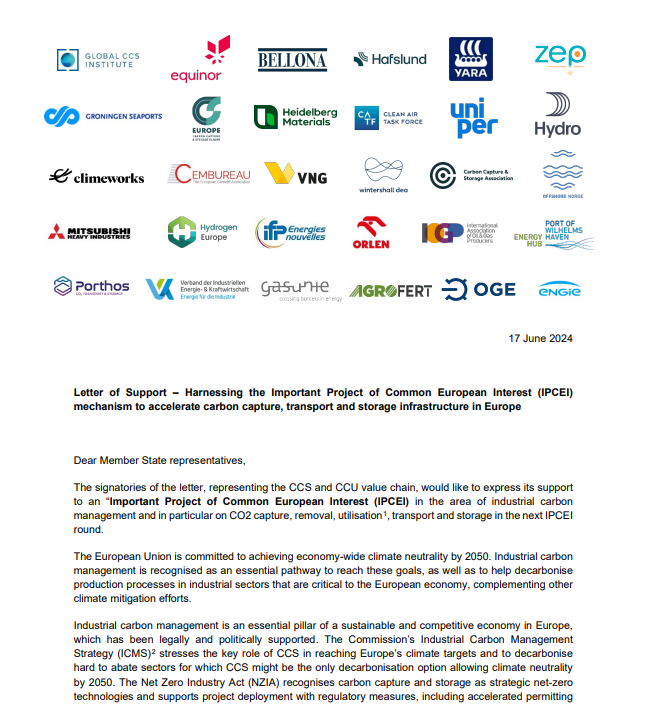
Joint Statement – Harnessing the IPCEI mechanism for CCS in Europe
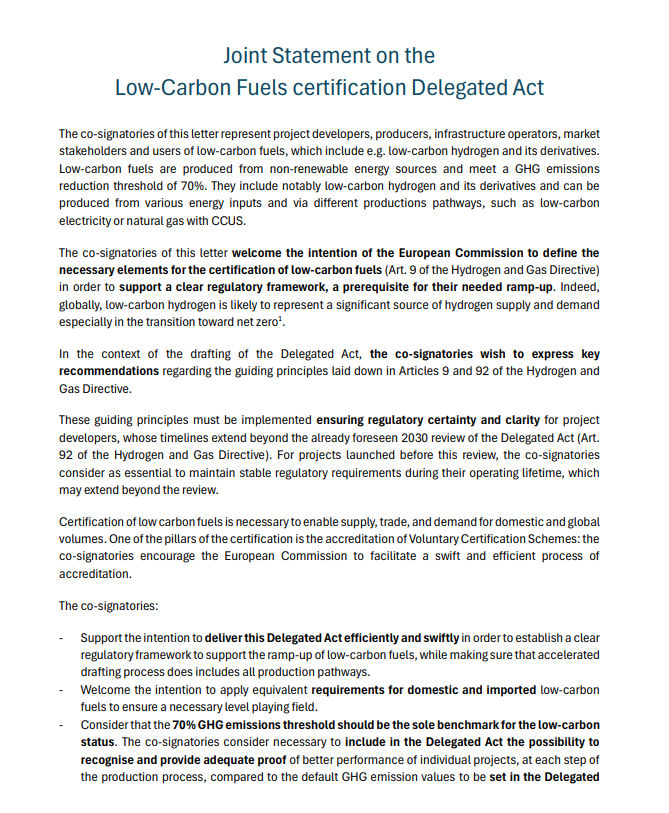
Joint Statement on the Low-Carbon Fuels certification Delegated Act

GasNaturally Letter to Competitiveness Council 23 May 2024
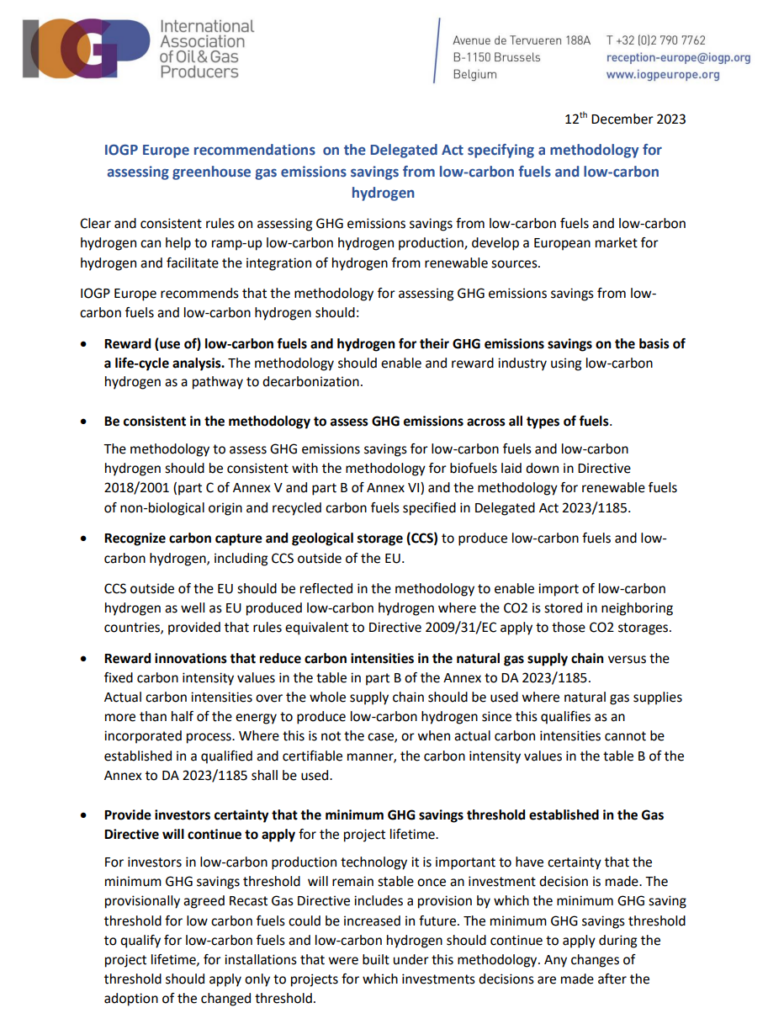
IOGP Europe recommendations on the Delegated Act specifying a methodology for assessing GHG emissions savings from low-carbon fuels and low-carbon hydrogen
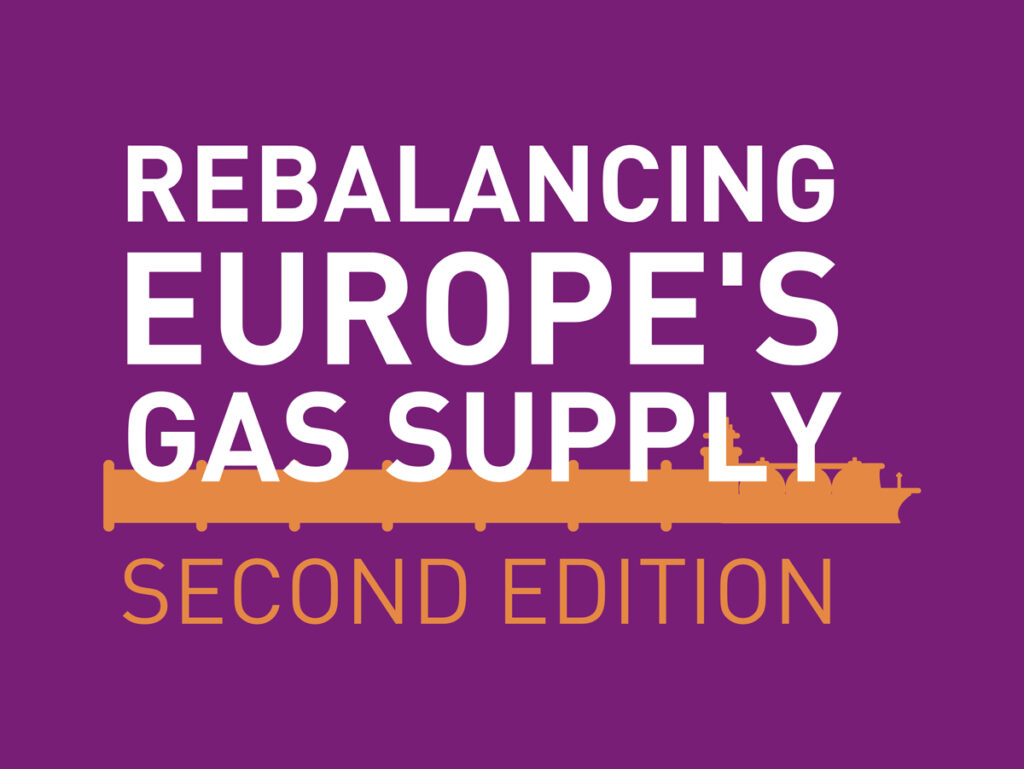
Rebalancing Europe’s Gas Supply Second Edition
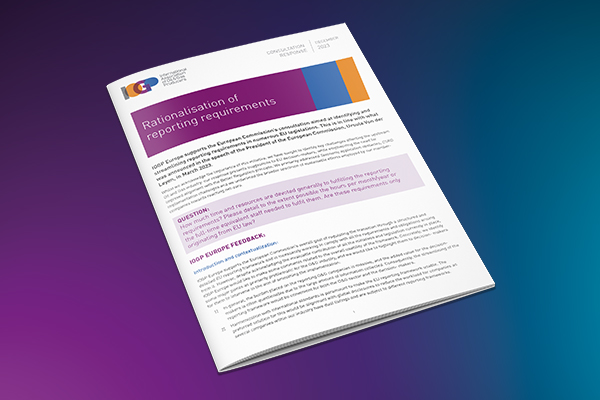
IOGP consultation response: Rationalisation of reporting requirements
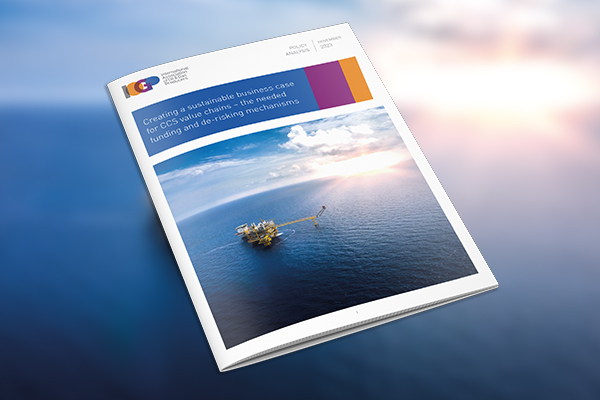
Creating a sustainable business case for CCS value chains
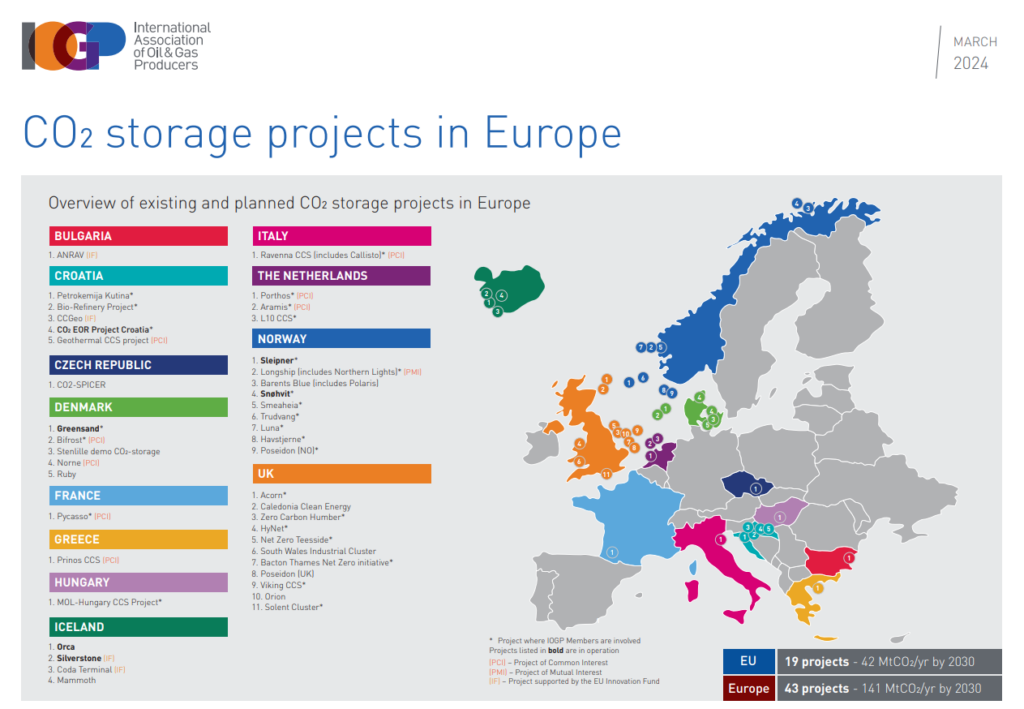
Map of CO2 storage Projects in Europe
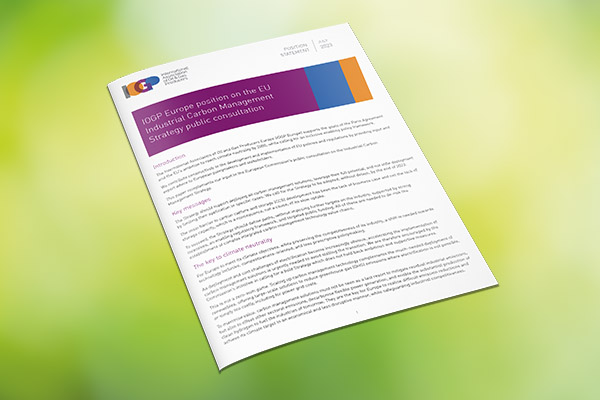
IOGP Europe position on the EU Industrial Carbon Management
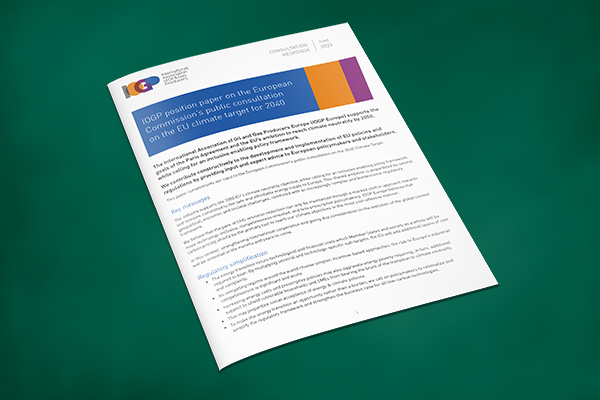
IOGP position paper on the European Commission’s public consultation on the EU climate target for 2040
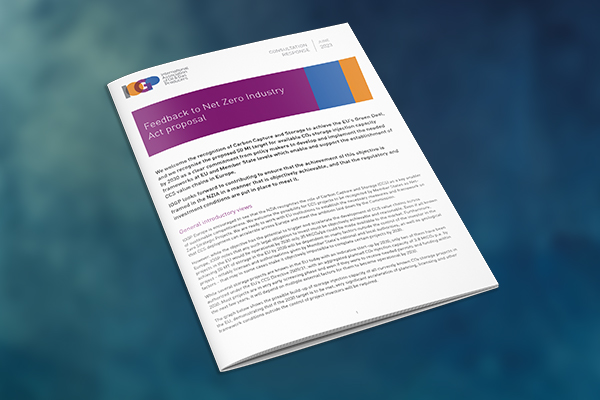
IOGP Europe feedback on Net Zero Industry Act proposal
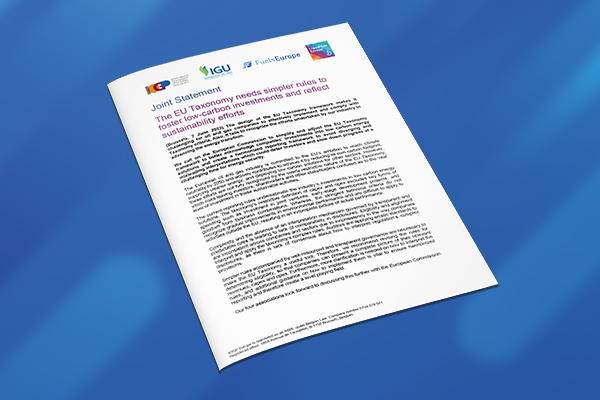
Joint industry statement on the EU Taxonomy
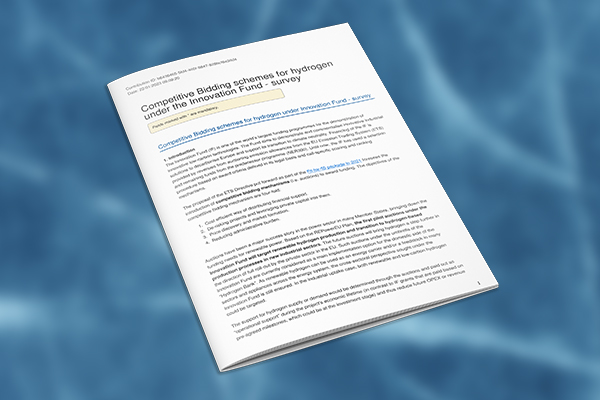
IOGP response on Competitive Bidding schemes for hydrogen under the Innovation Fund
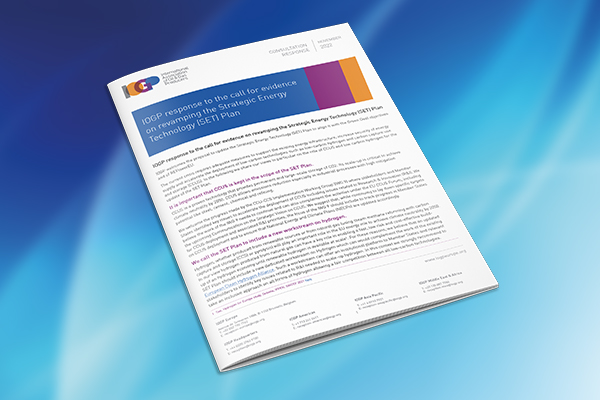
IOGP response on revamping the Strategic Energy Technology (SET) Plan
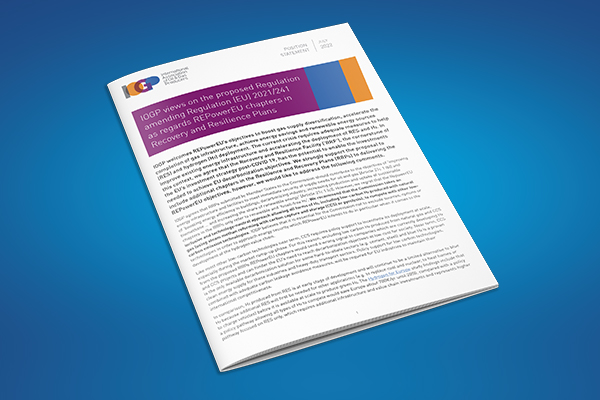
IOGP views on the proposed Regulation amending Regulation (EU) 2021/241 as regards REPowerEU chapters in Recovery and Resilience Plans
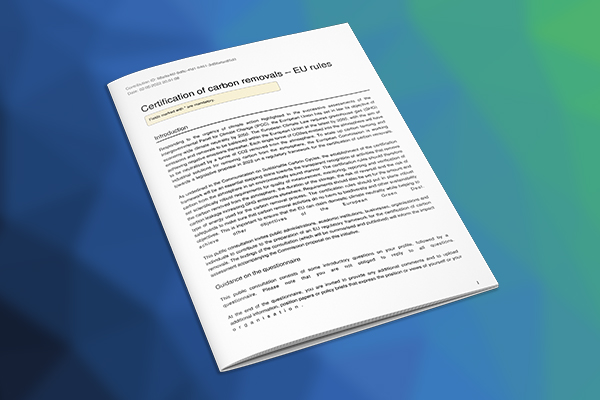
IOGP response to the consultation on certification of carbon removals – EU rules
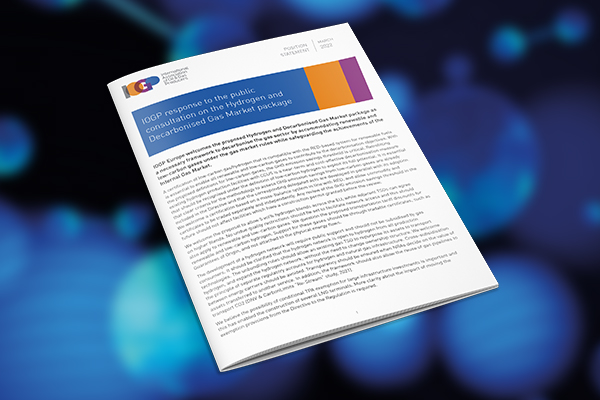
IOGP response to the public consultation on the Hydrogen and Decarbonized Gas Market package
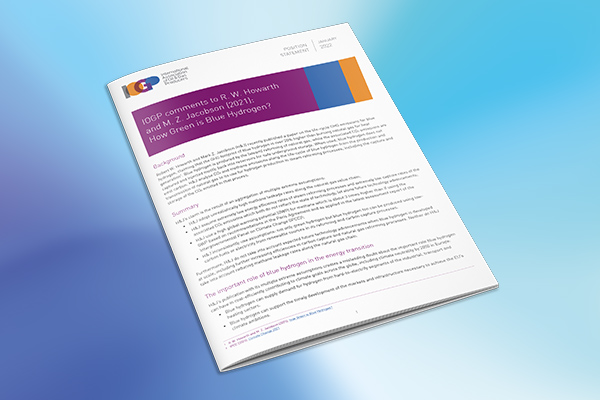
IOGP comments to R. W. Howarth and M. Z. Jacobson (2021): How Green is Blue Hydrogen?
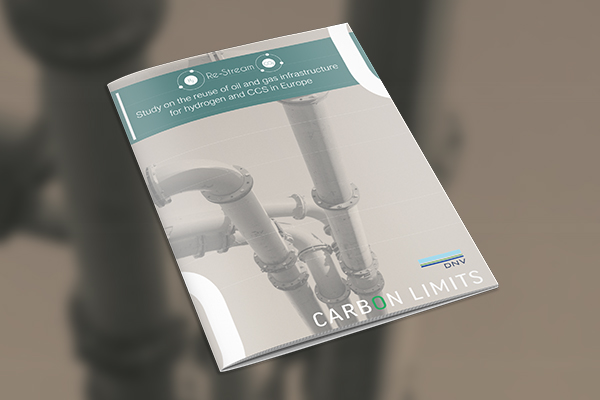
Re-Stream – Study on the reuse of oil and gas infrastructure for hydrogen and CCS in Europe
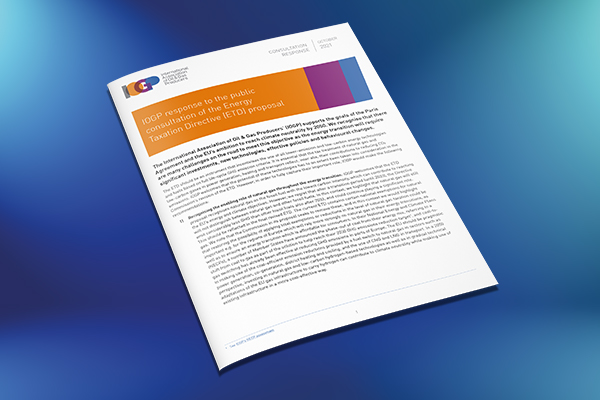
IOGP response to the public consultation on the Energy Taxation Directive (ETD) proposal
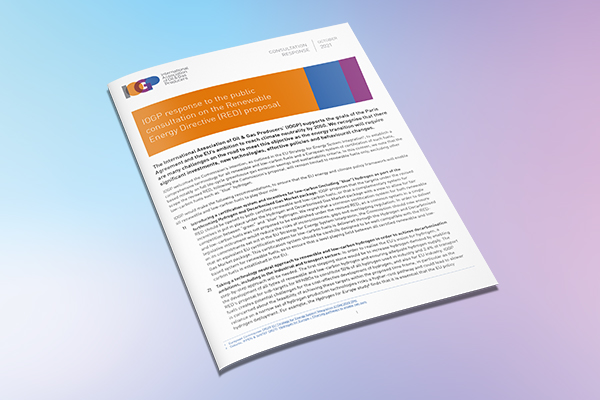
IOGP response to the public consultation on the Renewable Energy Directive (RED) proposal
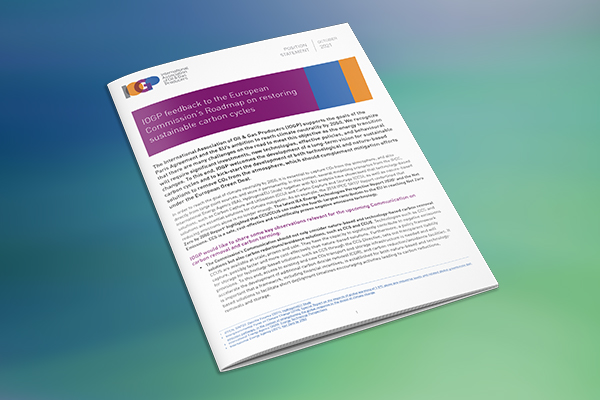
IOGP feedback to the European Commission’s Roadmap on restoring sustainable carbon cycles
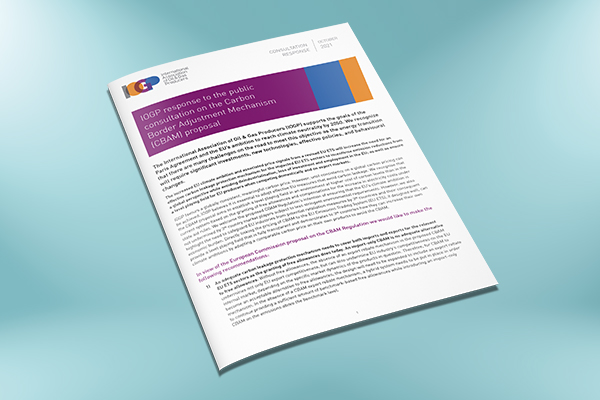
IOGP response to the public consultation on the Carbon Border Adjustment Mechanism (CBAM) proposal
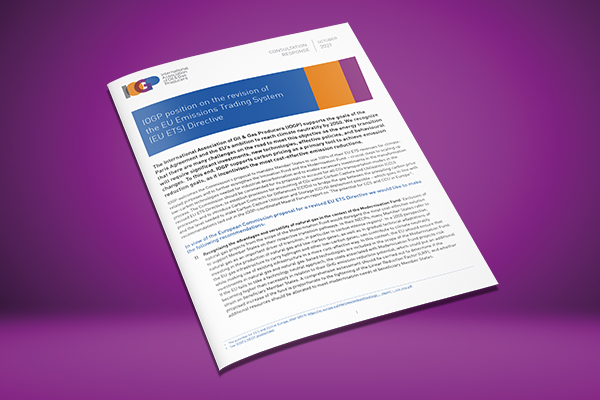
IOGP position on the revision of the EU Emissions Trading System (EU ETS) Directive
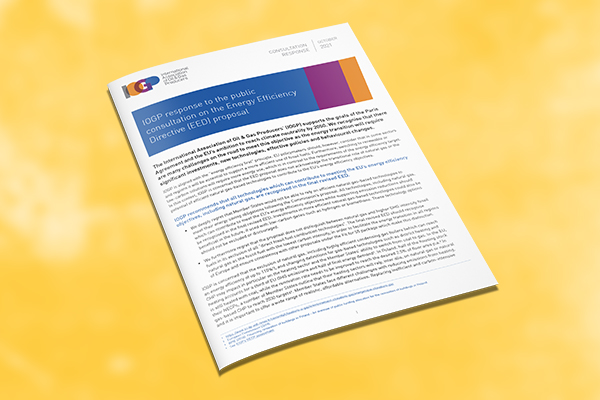
IOGP response to the public consultation on the Energy Efficiency Directive (EED) proposal

IOGP response to the public consultation on the FuelEU Maritime proposal
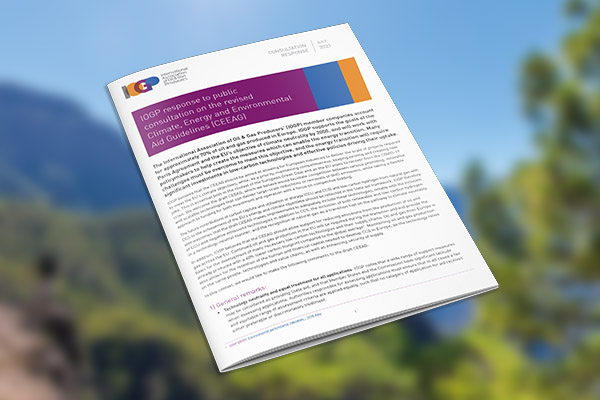
IOGP response to public consultation on the revised Climate, Energy and Environmental Aid Guidelines (CEEAG)

IOGP Paper on metric to use for 2030 targets
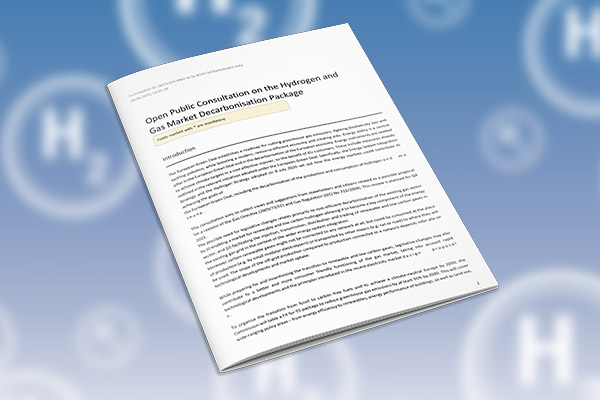
IOGP input to the consultation on the Hydrogen and Gas Market Decarbonization Package
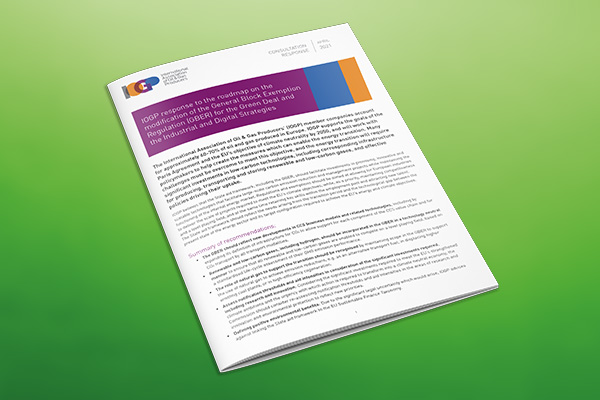
IOGP response to the roadmap on the modification of the General Block Exemption Regulation (GBER)
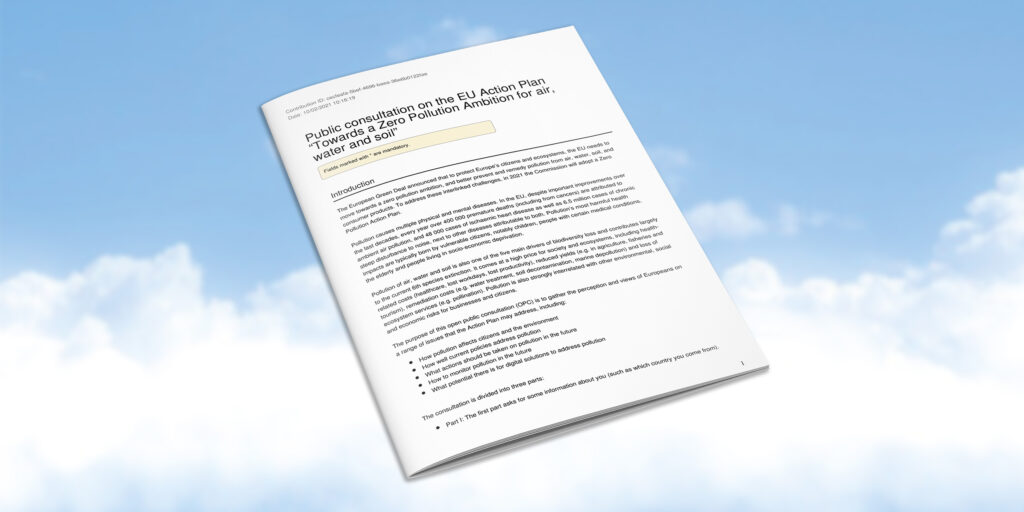
Public consultation on the EU Action Plan “Towards a Zero Pollution Ambition for air, water and soil”
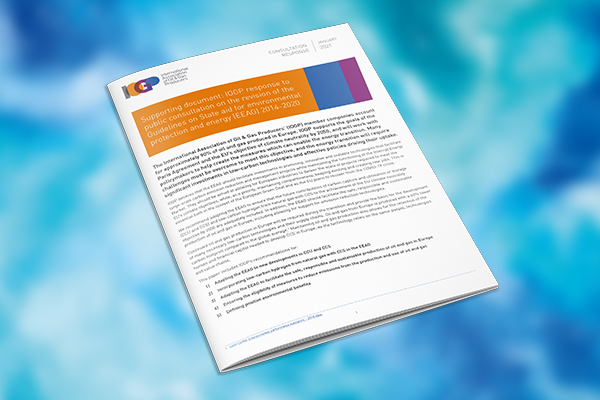
IOGP response to consultation on the revision of the Guidelines on State aid for environmental protection and energy (EEAG)

IOGP response to the Inception Impact Assessment on the revision of the Guidelines on State aid for environmental protection and energy (EEAG) 2014-2020
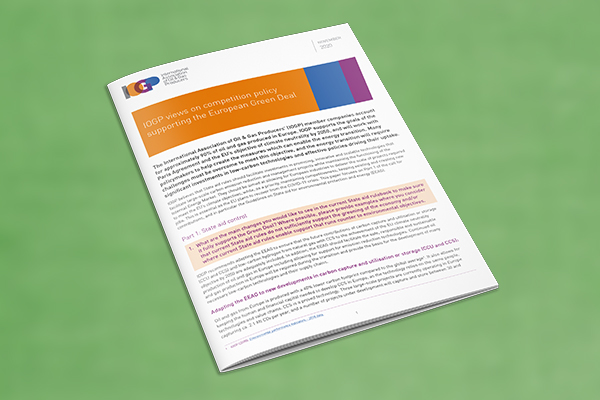
IOGP views on competition policy supporting the European Green Deal
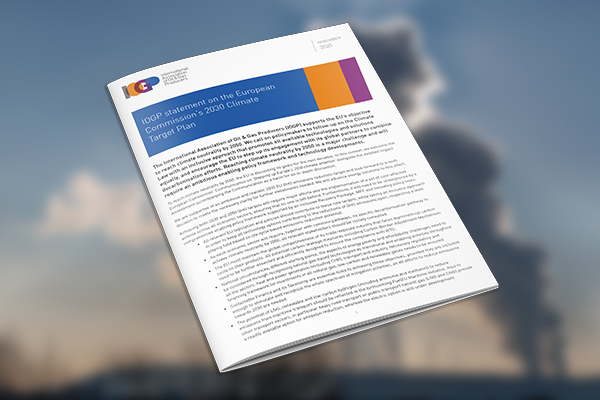
IOGP statement on the European Commission’s 2030 Climate Target Plan
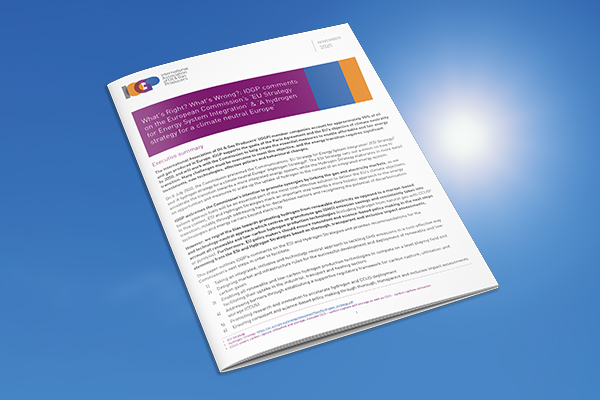
What’s Right? What’s Wrong? IOGP comments on the ‘EU Strategy for Energy System Integration’ and ‘A hydrogen strategy for a climate neutral Europe’
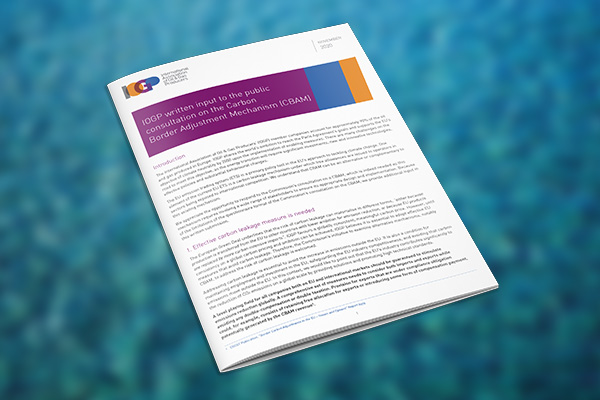
IOGP written input to the public consultation on the Carbon Border Adjustment Mechanism (CBAM)
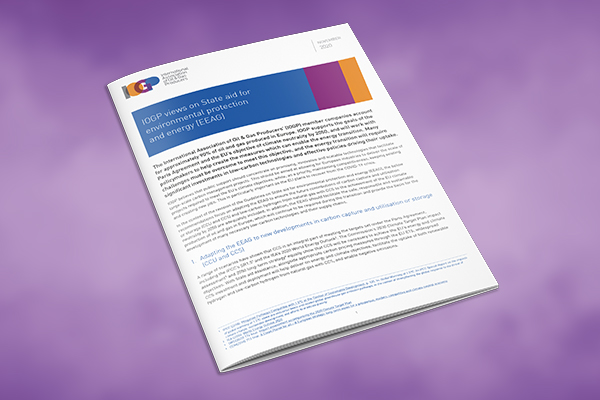
IOGP views on State aid for environmental protection and energy (EEAG)
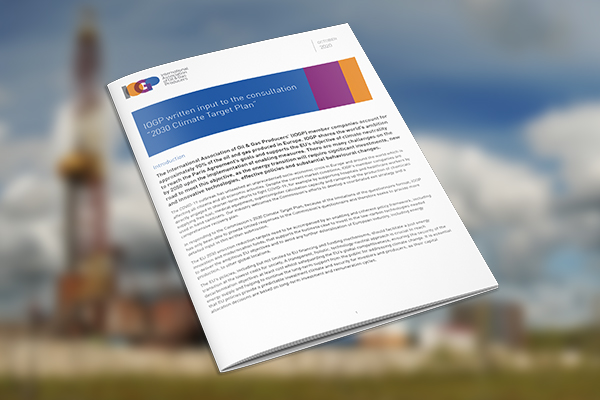
IOGP written input to the consultation “2030 Climate Target Plan”
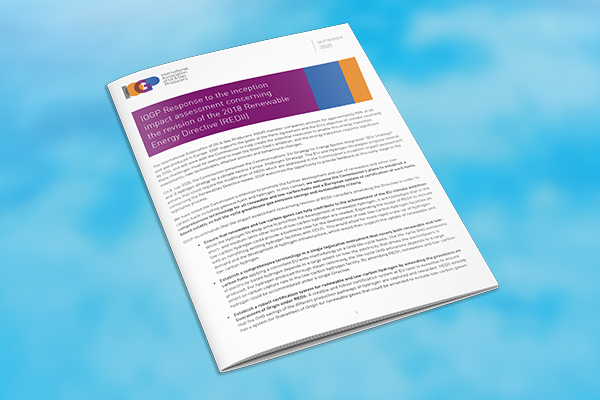
IOGP response to the inception impact assessment concerning the revision of the 2018 Renewable Energy Directive (REDII)
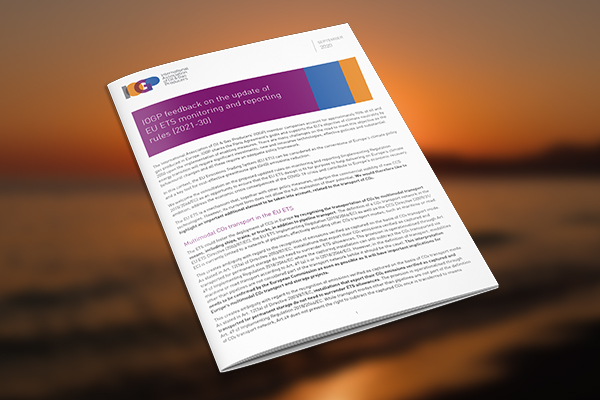
IOGP feedback on the update of EU ETS monitoring and reporting rules (2021-30)
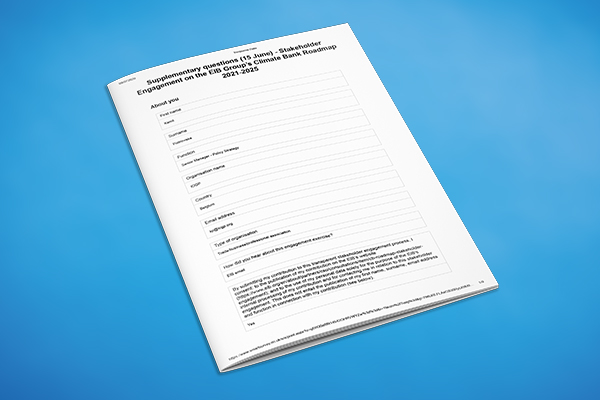
IOGP response to supplementary questions on the EIB Group’s Climate Bank Roadmap 2021-2025

IOGP response to consultation on the renewed Sustainable Finance strategy
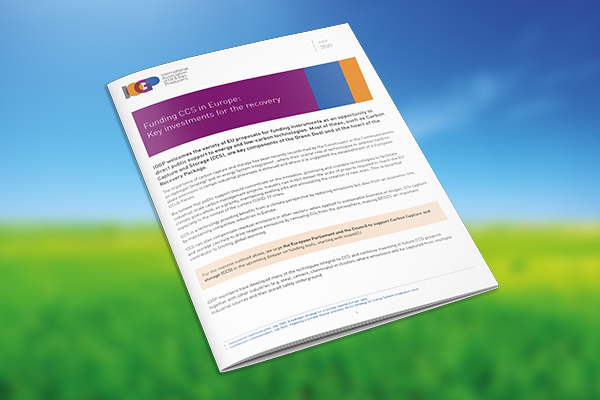
Funding CCS in Europe: key investments for the recovery
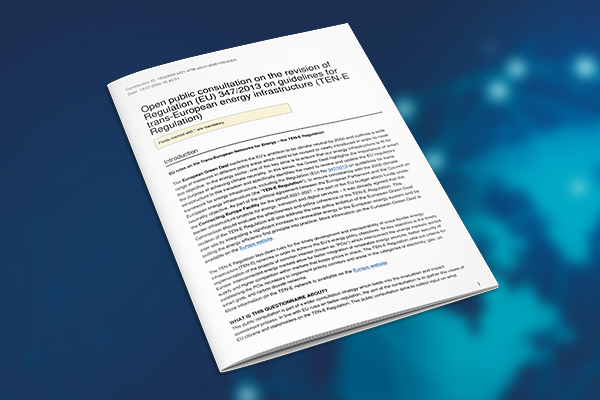
IOGP response to the public consultation on the revision of Regulation (EU) 347/2013 on guidelines for TEN-E Regulation
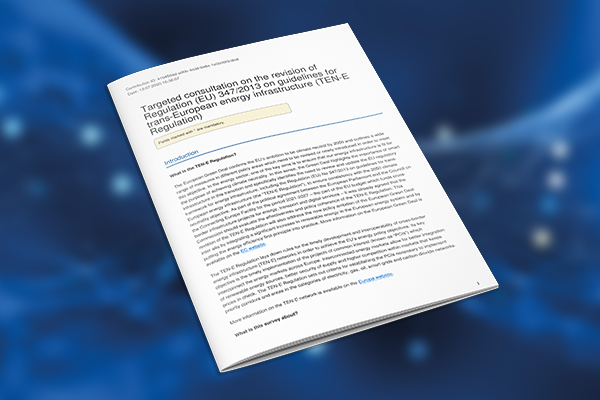
IOGP response to targeted consultation on the revision of Regulation (EU) 347/2013 on guidelines for TEN-E Regulation

IOGP input to the Roadmap on the EU Smart System Integration
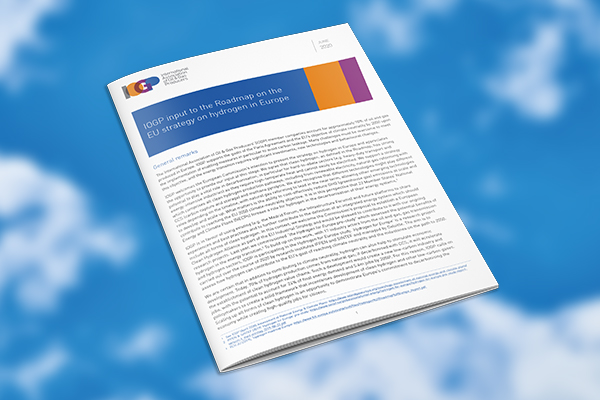
IOGP input to the Roadmap on the EU strategy on hydrogen in Europe

IOGP feedback to the Combined Evaluation Roadmap/Inception Impact Assessment on the revision of Regulation (EU) 347/2013 on guidelines for TEN-E
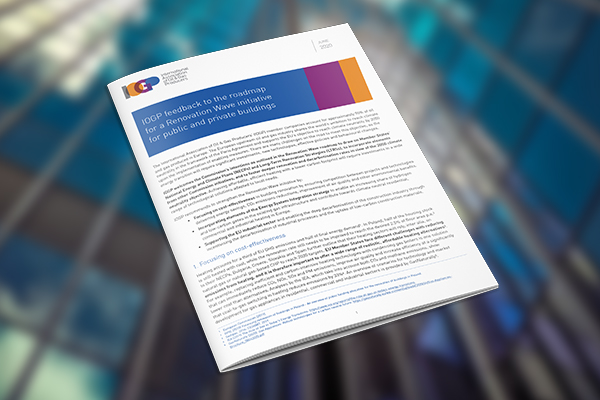
IOGP feedback to the roadmap for a Renovation Wave initiative for public and private buildings
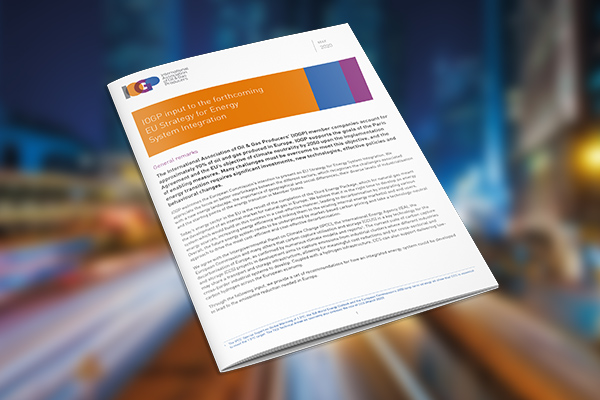
IOGP input to the forthcoming EU Strategy for Energy System Integration
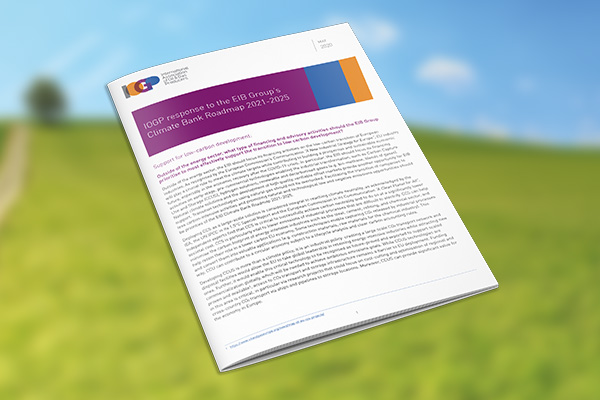
IOGP response to the EIB Group’s Climate Bank Roadmap 2021-2025

Input to the inception impact assessment on the FuelEU Maritime
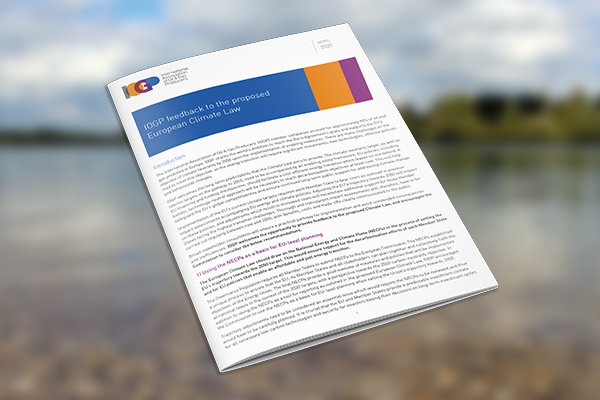
IOGP feedback to the proposed European Climate Law

Feedback to the impact inception assessment “2030 Climate Target Plan”
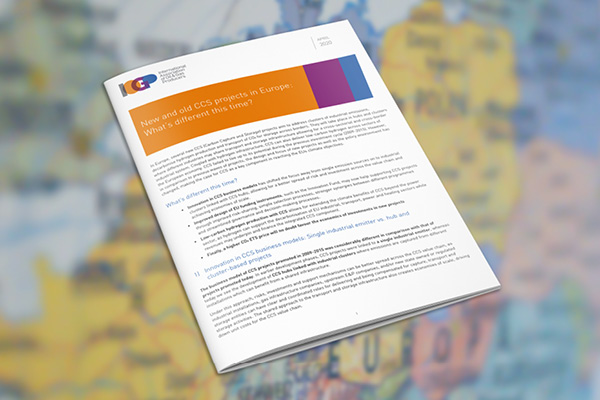
New and old CCS projects in Europe: What’s different this time?
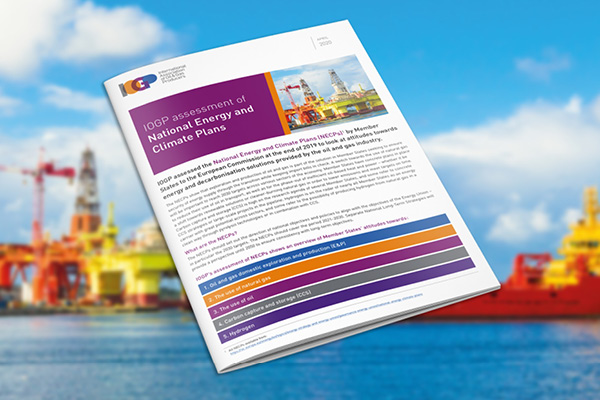
IOGP assessment of National Energy and Climate Plans
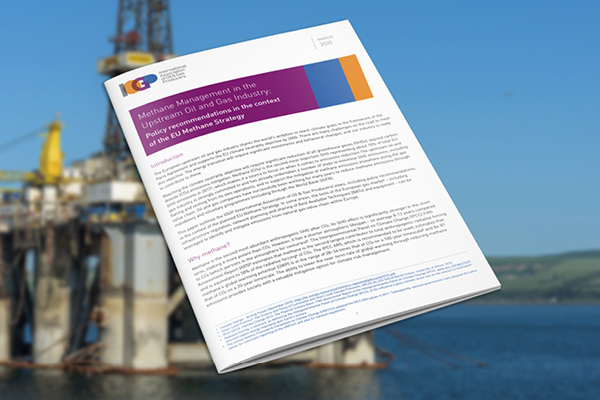
Methane Management in the Upstream Oil and Gas Industry: Policy recommendations in the context of the EU Methane Strategy

Scaling up Hydrogen in Europe
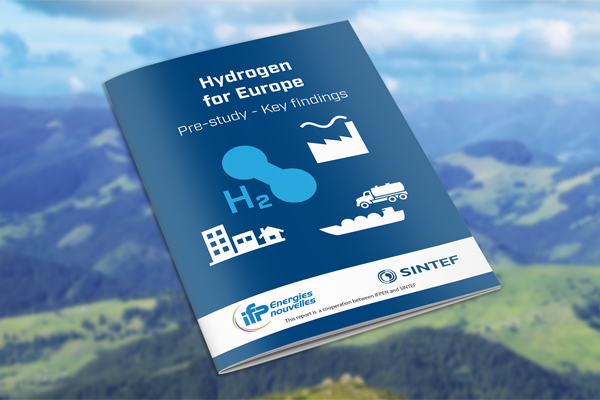
Hydrogen for Europe Pre-study – Key findings
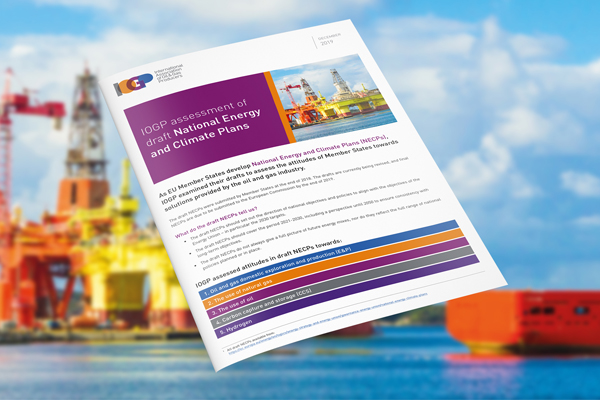
IOGP assessment of draft National Energy and Climate Plans
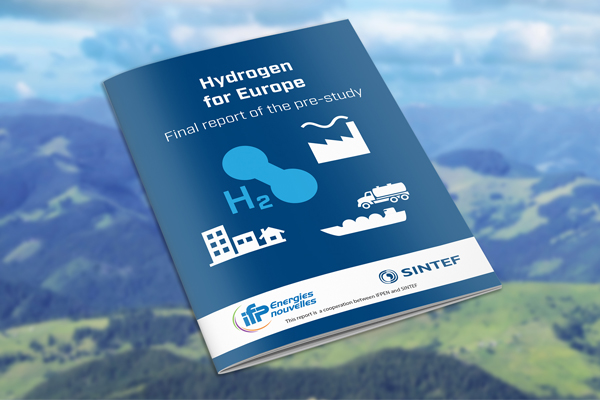
Hydrogen for Europe
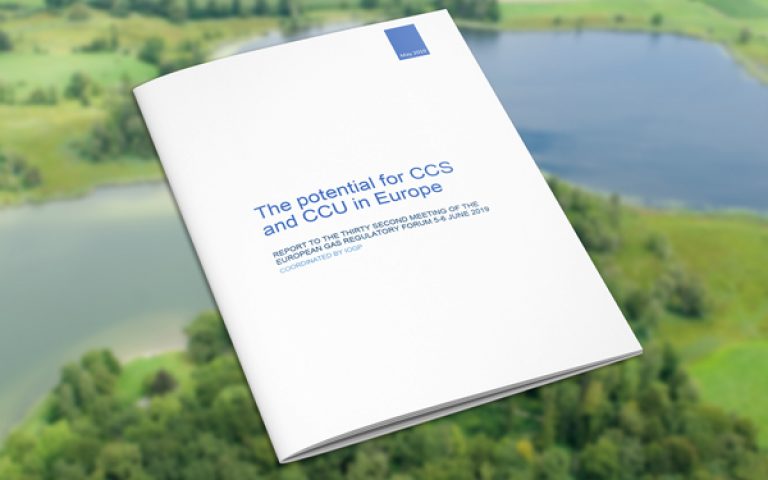
The potential for CCS and CCU in Europe Report to the thirty second meeting of the European Gas Regulatory Forum 5-6 June 2019

LNG – a fast lane to make Europe a leader in clean shipping
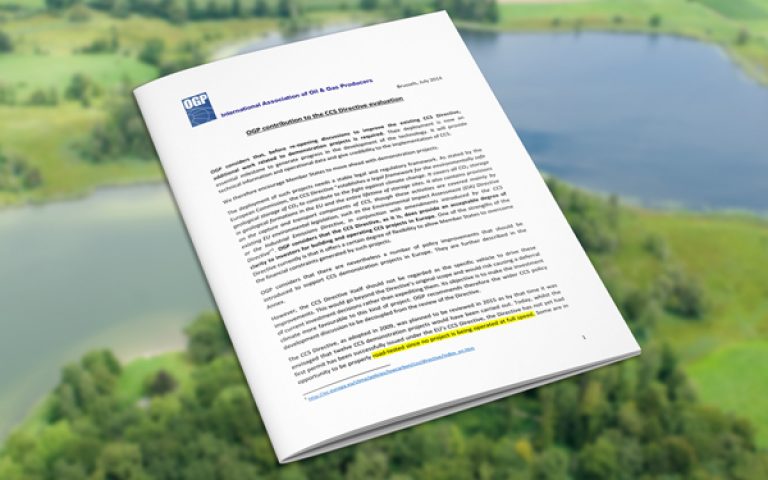
OGP contribution to the CCS Directive evaluation

Draghi Report: a pragmatic pathway to Competitiveness, Sustainability, and Resilience
IOGP Europe joined BusinessEurope in industrial permitting task force
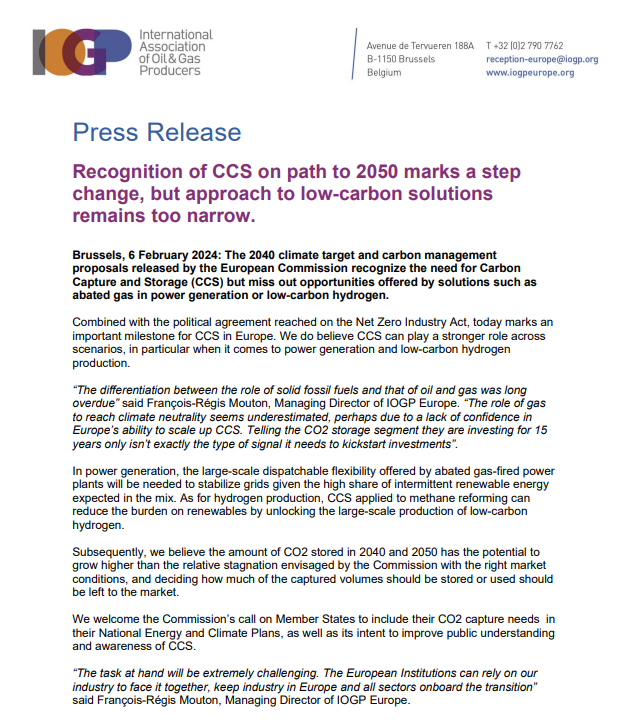
Press release: Recognition of CCS on path to 2050 marks a step change, but approach to low-carbon solutions remains too narrow.
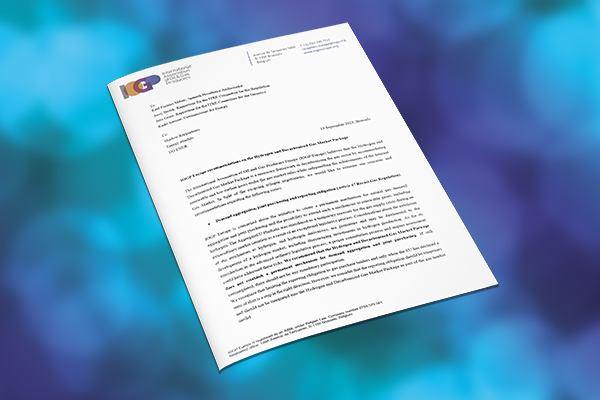
Letter: IOGP Europe recommendations on the Hydrogen and Decarbonized Gas Market Package
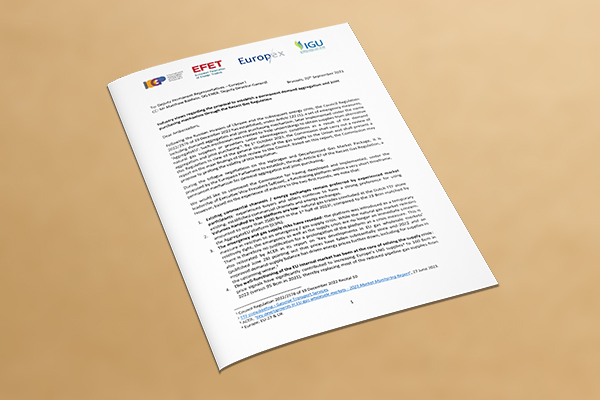
Letter: Industry views regarding the proposal to establish a permanent demand aggregation and joint purchasing mechanism through the Recast Gas Regulation
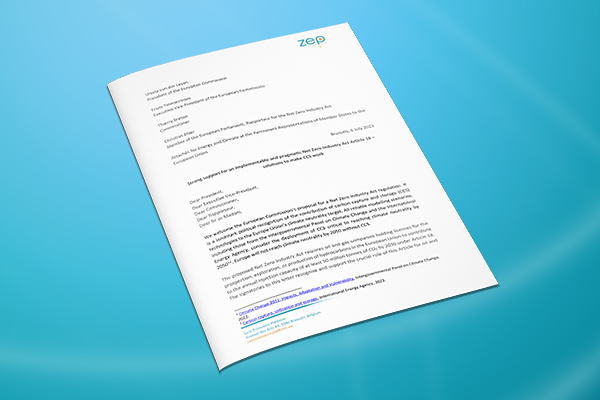
Letter: Strong support for an implementable and pragmatic Net Zero Industry Act Article 18 – solutions to make CCS work
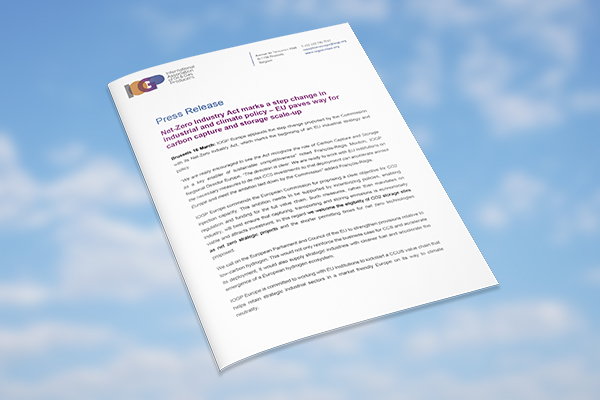
Net-Zero Industry Act marks a step change in industrial and climate policy – EU paves way for carbon capture and storage scale-up

Letter: Open, inclusive, and pragmatic Green Deal Industrial Plan for Europe
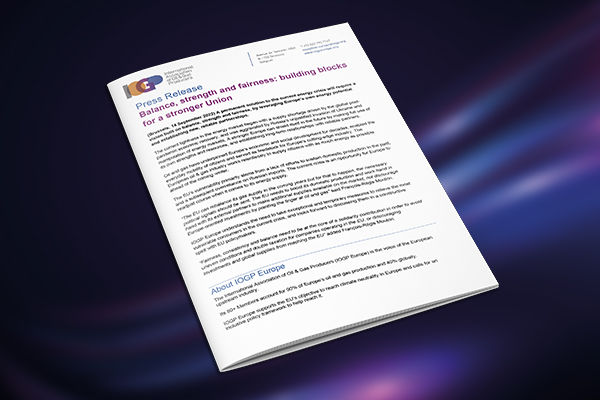
Balance, strength and fairness: building blocks for a stronger Union
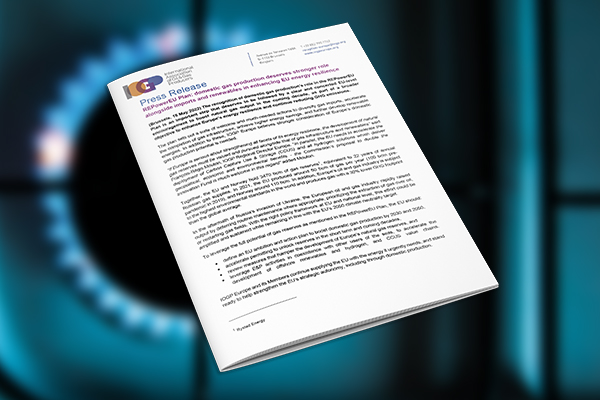
REPowerEU Plan: domestic gas production deserves stronger role alongside imports and renewables in enhancing EU energy resilience
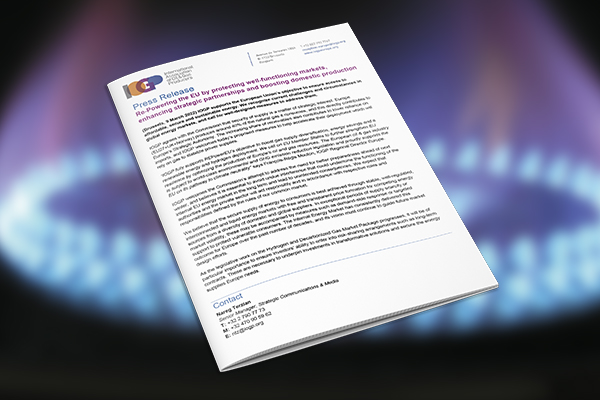
Re-Powering the EU by protecting well-functioning markets, enhancing strategic partnerships and boosting domestic production
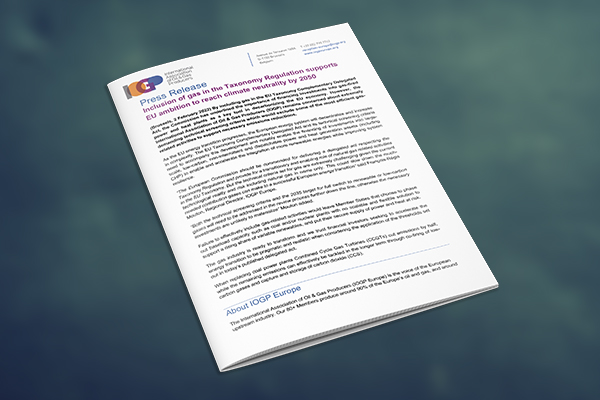
Inclusion of gas in the Taxonomy Regulation supports EU ambition to reach climate neutrality by 2050
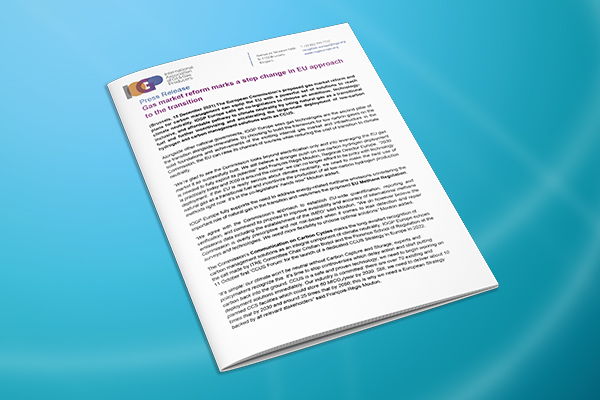
Gas market reform marks a step change in EU approach to the transition
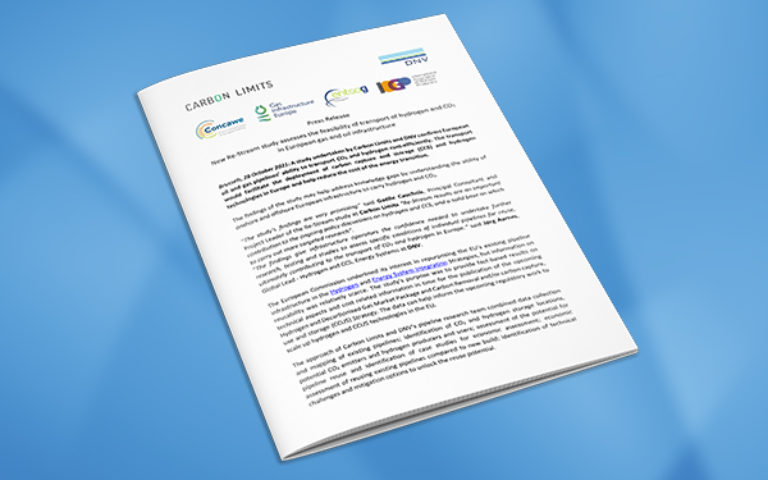
New Re-Stream study assesses the feasibility of transport of hydrogen and CO2 in European gas and oil infrastructure
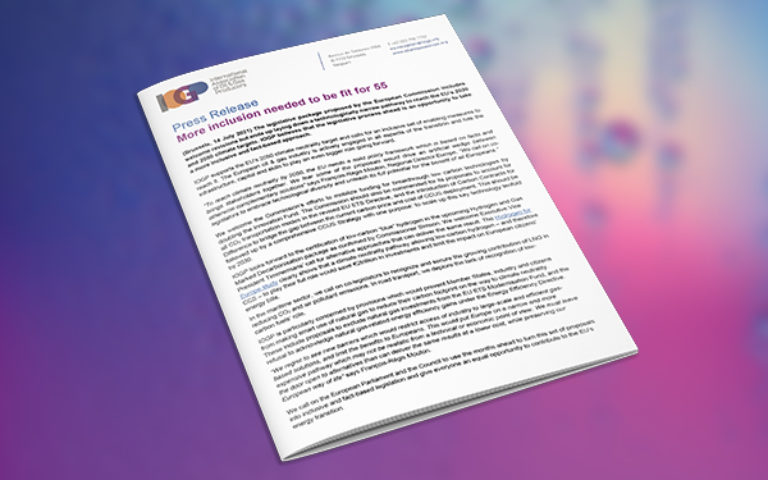
More inclusion needed to be fit for 55
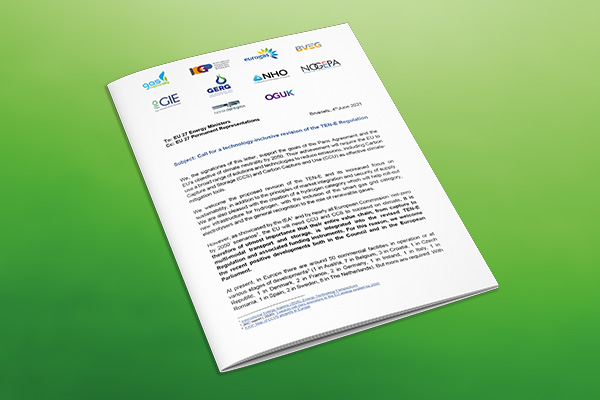
Letter: Call for a technology-inclusive revision of the TEN-E Regulation
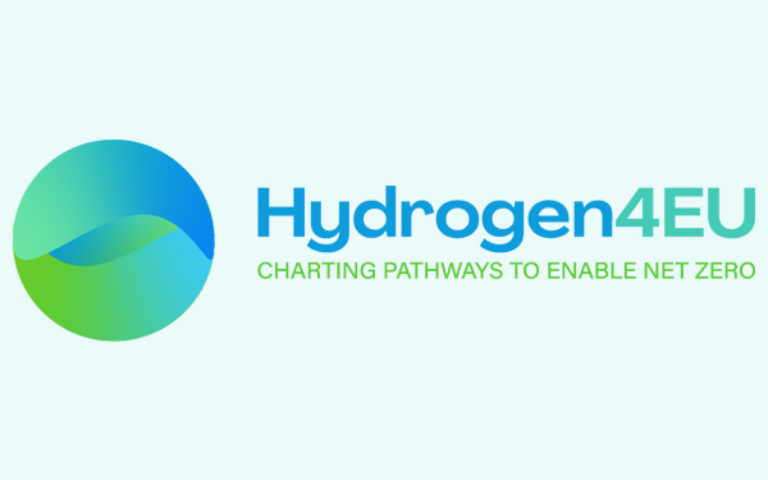
“Hydrogen for Europe” study launch
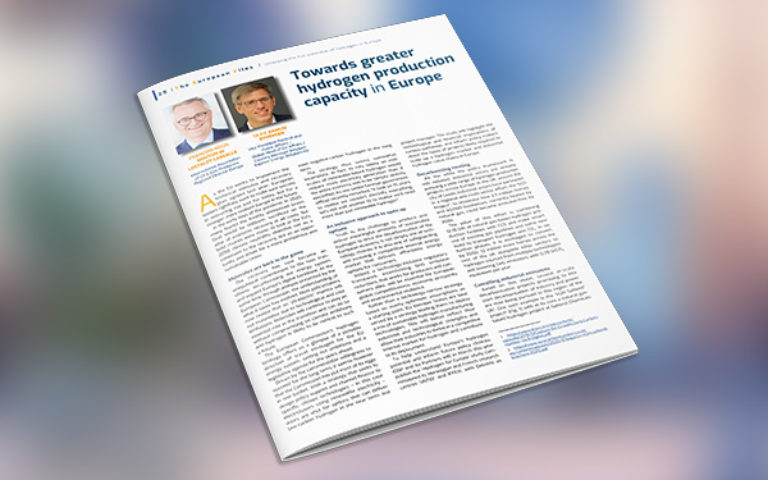
Towards greater hydrogen production capacity in Europe
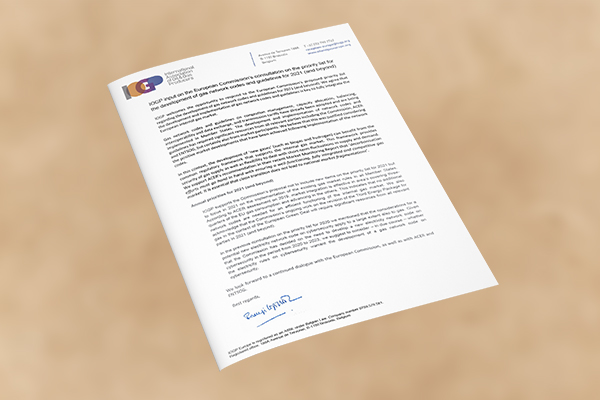
Letter: IOGP input on the European Commission’s consultation on the priority list for the development of gas network codes and guidelines for 2021 (and beyond)
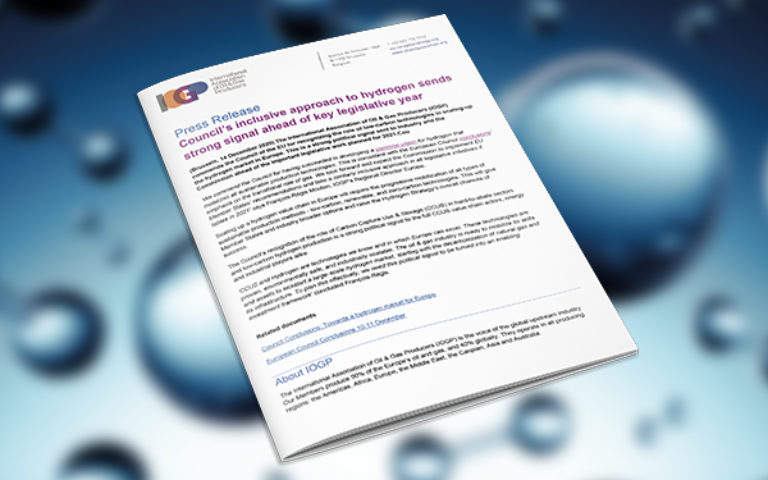
Council’s inclusive approach to hydrogen sends strong signal ahead of key legislative year

Letter: 57 industry leaders call for enhancing gas contribution to decarbonisation
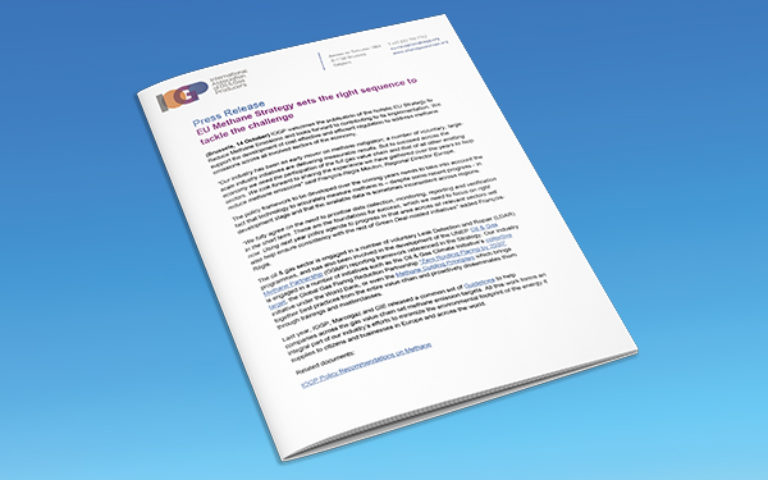
EU Methane Strategy sets the right sequence to tackle the challenge
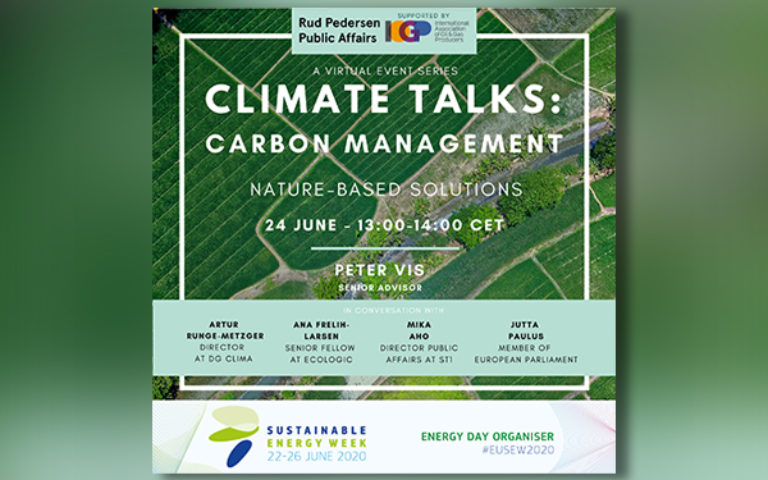
Carbon Management Webinars
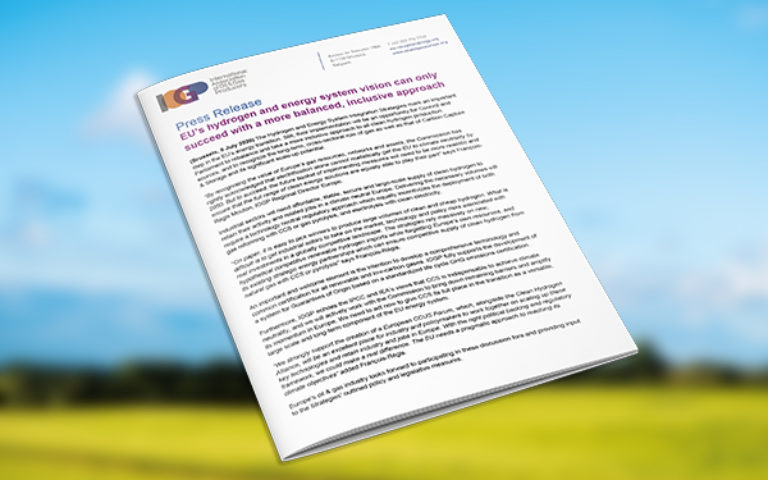
EU’s hydrogen and energy system vision can only succeed with a more balanced, inclusive approach
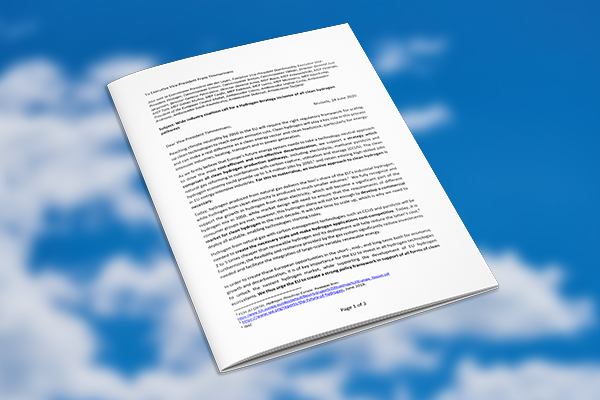
Wide industry coalition call for a Hydrogen Strategy inclusive of all clean hydrogen pathways
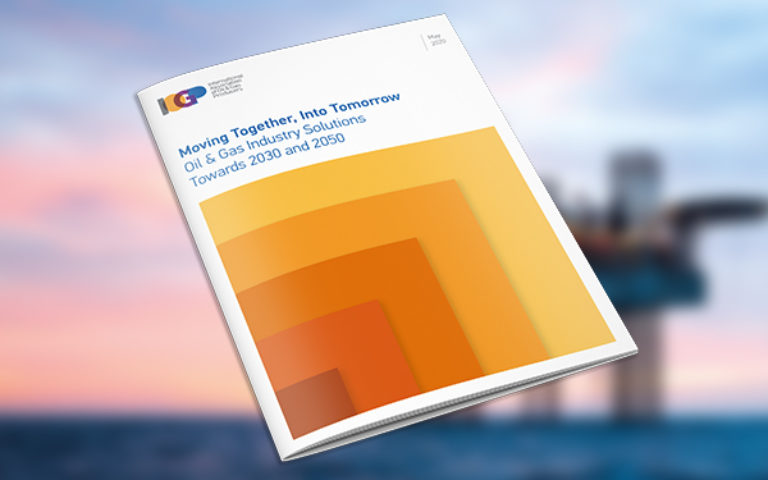
Manifesto: Oil & Gas Industry Solutions Towards 2030 and 2050

Climate change, purpose & doing the right thing: lessons from COVID-19
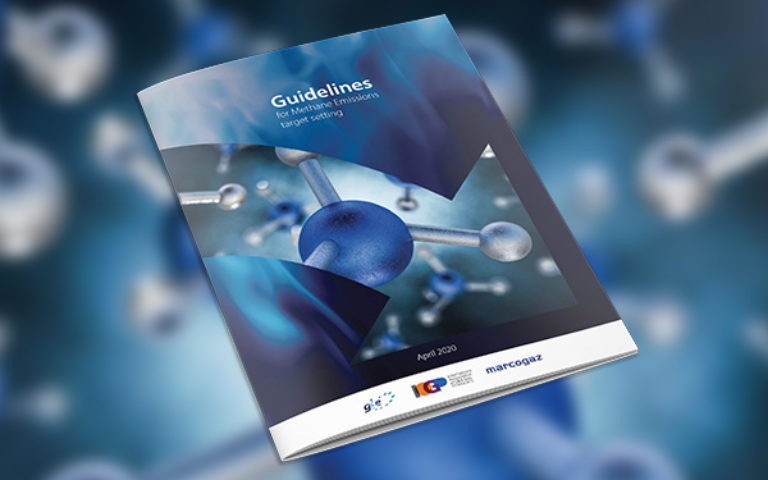
Guidelines for Methane Emissions target setting
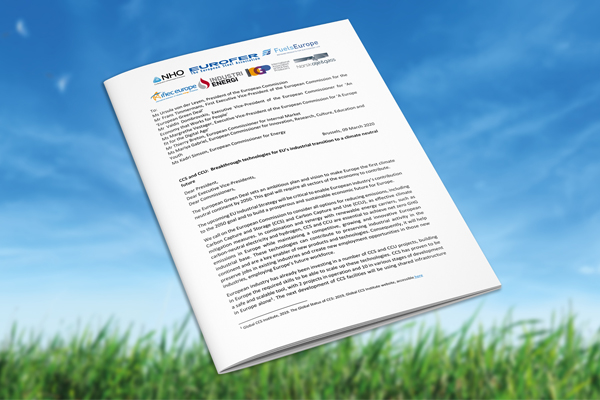
Joint letter: CCS and CCU for the EU’s Industrial Transition
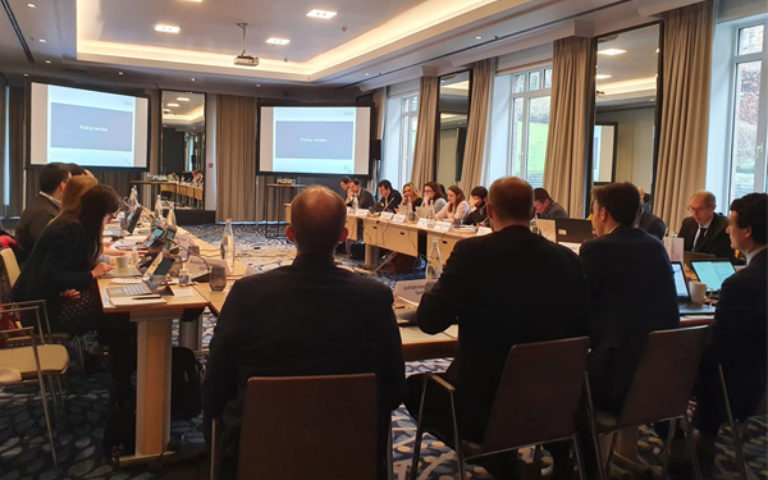
Hydrogen for Europe: 1st Working Group Meeting
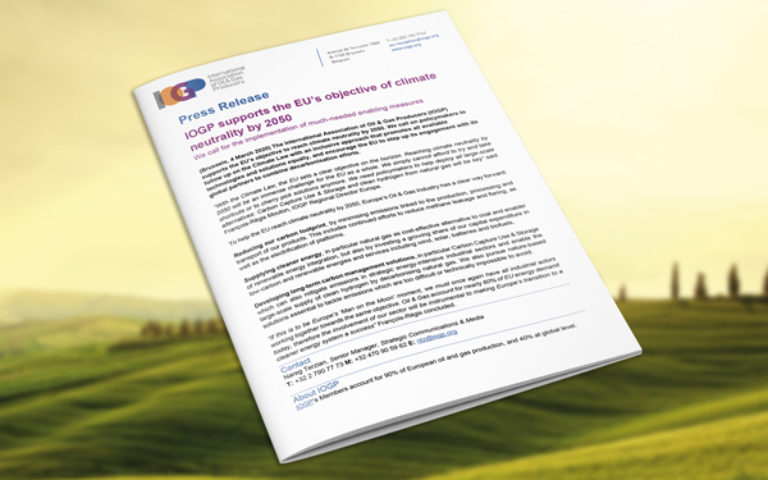
IOGP supports the EU’s objective of climate neutrality by 2050
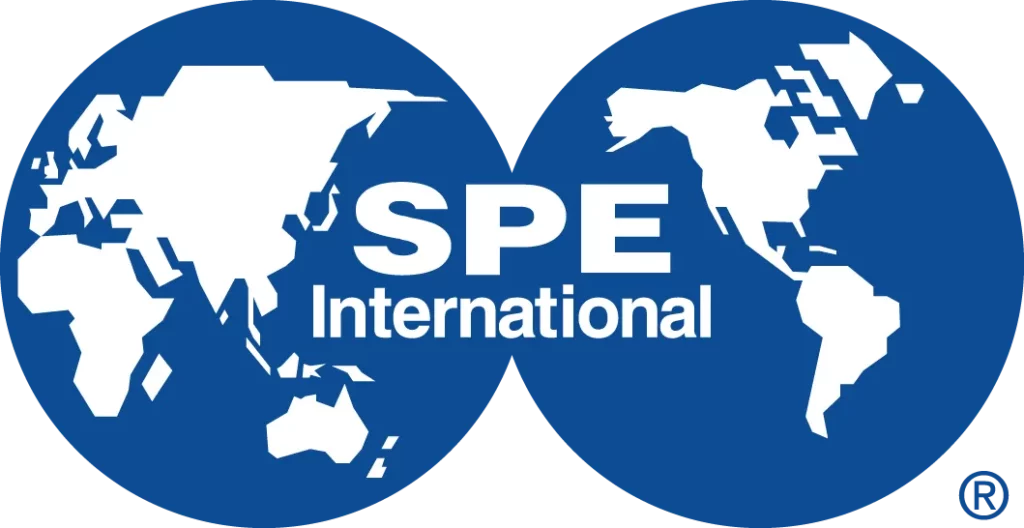
SPE Europe Energy Conference
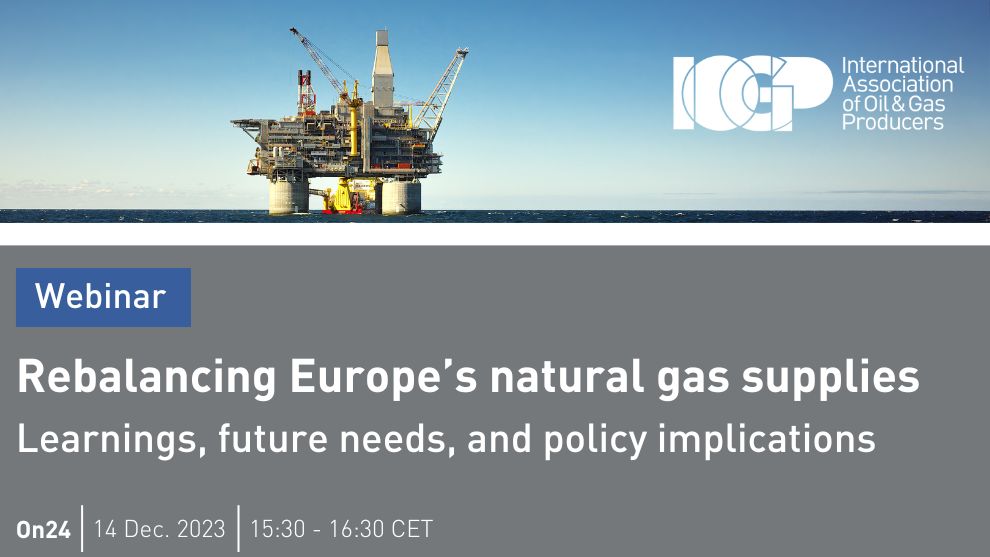
Rebalancing Europe’s natural gas supplies – Learnings, future needs, and policy implications

Scaling up the energy transition whilst securing a stable suppy
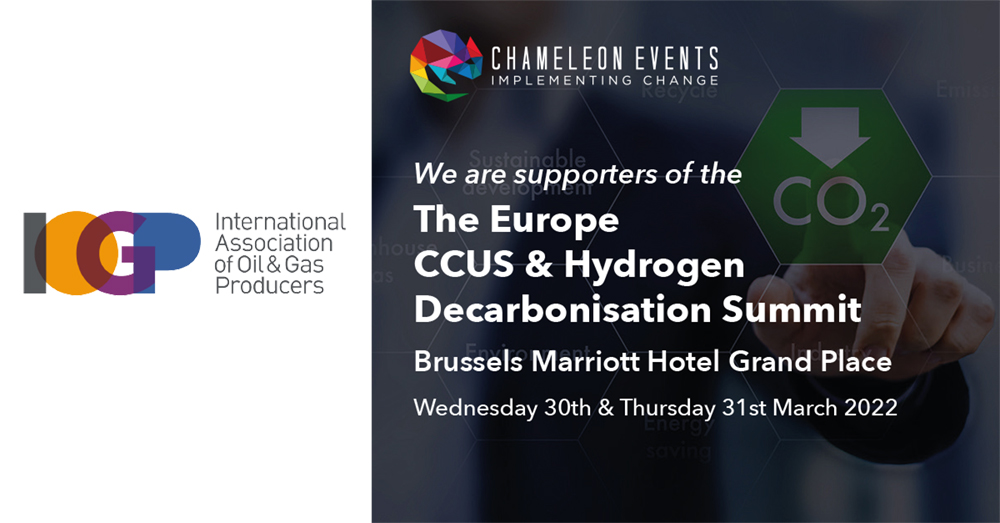
The Europe CCUS & Hydrogen Decarbonisation Summit
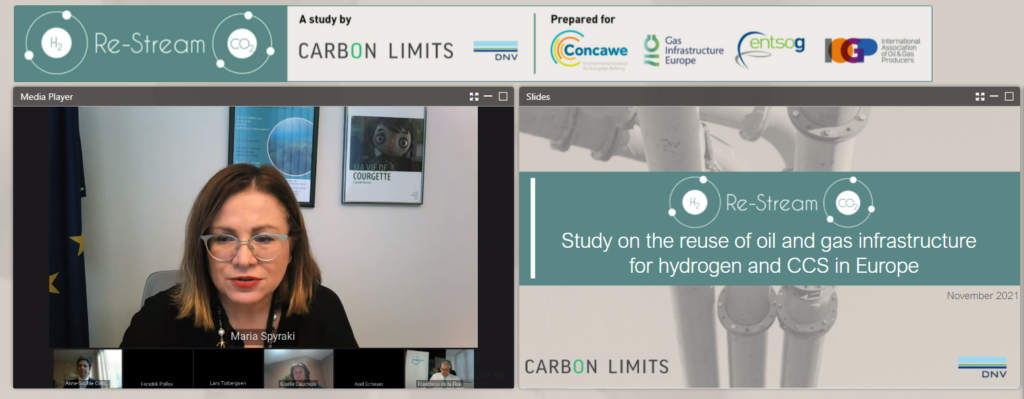
Re-Stream Study Launch Event
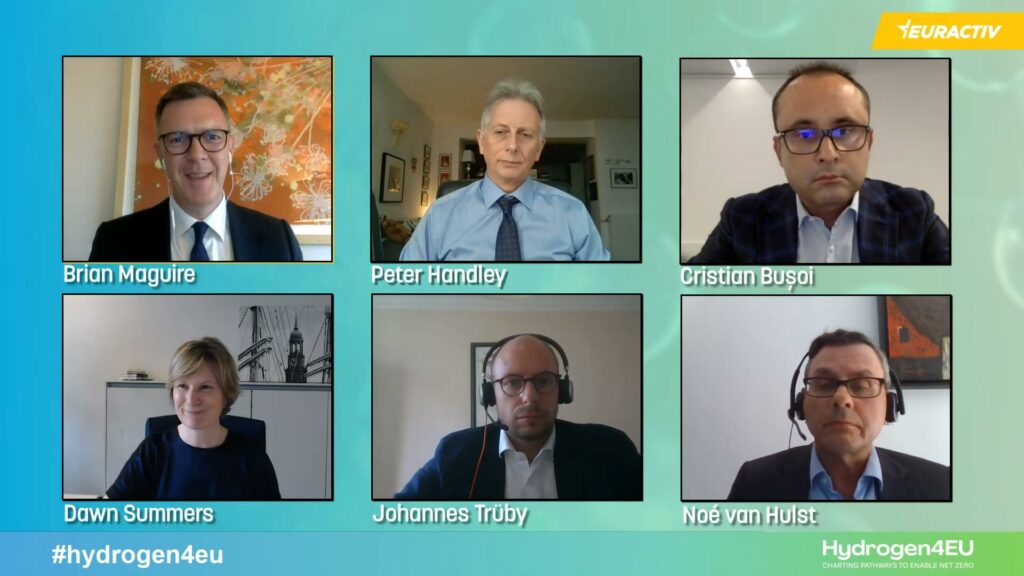
Hydrogen4EU Launch Event
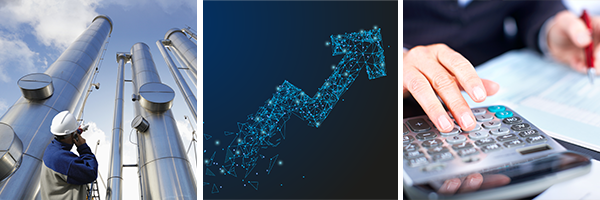
Sustainable finance: investor, oil and gas sector and global perspectives

Carbon Management Webinars

Sustainable finance: non-financial disclosure for the oil and gas sector and EU taxonomy in practice
